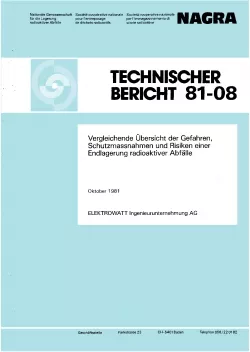
Technischer Bericht NTB 81-08
Vergleichende Übersicht der Gefahren, Schutzmassnahmen und Risiken einer Endlagerung radioaktiver Abfälle
The purpose of this report is to present an overview of the anticipated risks of geologic disposal of radioactive wastes and to compare these to "conventional" risks, which voluntarily or involuntarily are associated with nature or with human activities and have accompanied mankind for long times.
Radioactive wastes which result from the generation of electricity by commercial nuclear reactors as well as those originating from research, industrial and medical applications necessitate prolonged isolation from the biosphere due to their long-lived, although decaying, toxicity. Chapter 2 of this report contains a survey of the nature and extent of the potential hazard of radioactive waste, drawing attention to the fact that the toxicity of radionuclides is comparable to that of nonradioactive chemical compounds. The possibility of adverse effects on the public cannot be ruled out for either kind of waste.
Current plans aim at the safe and effective disposal of radioactive wastes in deep and stable geological formations which should serve as hosts for engineered final repositories. For a final repository to be suitable the site chosen should be free from circulating groundwater or the free movement of the groundwater must be strongly restricted. In order to prevent radioactive substances migrating away from the final repository in which they have been placed, it is planned to utilise natural and man-made barriers which function largely independently from each other. Thorough knowledge of the properties of man-made barriers is as important as knowledge of the natural barriers, which are determined by the geology and hydrogeology of the site of the final repository. This principle of protection is known as a "multiple-barrier concept" and is considered capable of providing safe disposal of radioactive wastes.
But what is meant by "safe"? Safety is a relative rather than absolute notion; there is no such thing as "absolute safety", because there is always a residual risk associated with any activity. For activities involving exposure to radiation, the question of acceptable levels of safety has been directly studied. Based upon the goal that the cost-benefit-balance of all human activities should be positive, the International Commission for Radiological Protection (ICRP) in order to protect society and the individual has recommended the principle that the radiation doses should be kept as low as reasonably achievable, taking into account that economic and social factors must also be considered in defining any dose limitation system.
Complementary to the concept of safety for a final repository is the concept of risk to its environment, and this is the concept which one tries to quantify.
Risk comprises two essential factors:
- extent of the undesirable consequences (S) of an incident (e.g. death, injuries, property damage)
- the uncertainty of the incident, i.e. the probability (P) of the incident taking place during a given time period
In general, the risk R is taken to be the direct product of the two factors, but other weightings are also possible.
With respect to disposal of nuclear waste, risk is connected primarily with the increased radiation dose which might result from the intake of released radionuclides. Protective measures against additional radiation doses are described in chapter 3. This is followed in chapter 4 by an estimation of the risk associated with the final repository which enables the reader to assess this risk relative to other existing risks. This estimation is based upon many safety analyses which have been carried out in recent years to clarify both the nature and extent of the possible hazard associated with a final repository.
The broad conclusions drawn from safety studies to date are summarized in chapter 5 of this report. In general the risks associated with final disposal of radioactive wastes are estimated to be very low. Geologic disposal is certainly technically feasible, and the risks in both operational and post-closure phases in the life of a repository lie below those involved in many activities which are accepted today. Firmer conclusions will be possible when site-specific projects are analysed. With better site data and with improved modelling it is expected that risk estimates may be reduced even below the current conservatively calculated values.
